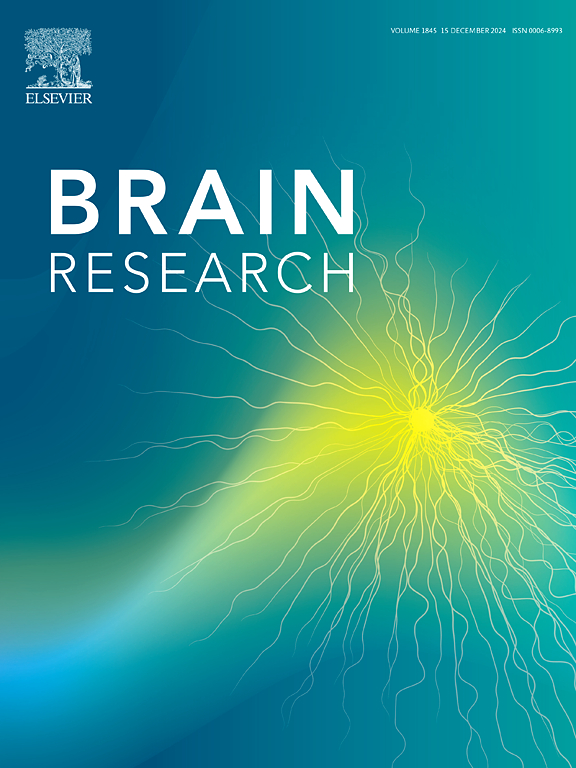USP7 promotes PINK1/Parkin-dependent mitophagy to ameliorate cerebral ischemia–reperfusion injury by deubiquitinating and stabilizing SIRT1
IF 2.7
4区 医学
Q3 NEUROSCIENCES
引用次数: 0
Abstract
Background
Cerebral ischemia–reperfusion (CI/R) injury, a major complication of ischemic stroke, is characterized by mitochondrial dysfunction and neuronal apoptosis, and understanding its underlying molecular mechanisms is essential for the development of effective therapeutic strategies. This study aimed to investigate the role of ubiquitin-specific protease 7 (USP7) in CI/R injury and elucidate its regulatory mechanisms.
Methods
A rat model of middle cerebral artery occlusion/reperfusion (MCAO/R) and an in vitro neuronal model subjected to oxygen-glucose deprivation/reperfusion (OGD/R) were used to mimic CI/R injury. USP7 was overexpressed or knocked down, with or without co-treatment, using the autophagy inhibitor 3-methyladenine (3-MA). Neurological function was evaluated using standardized scoring systems, and cerebral infarct volume was quantified by TTC staining. Histopathological changes in the cortex and hippocampus were assessed using hematoxylin-eosin (HE) and Nissl staining. Neuronal viability and apoptosis were measured by CCK-8 assay, TUNEL staining, and flow cytometry. To assess cellular metabolism and oxidative stress, ATP and LDH levels, along with antioxidant markers (including SOD, GSH, and GSH-Px), were analyzed using commercial biochemical kits. Mitochondrial morphology and autophagosome formation were visualized using transmission electron microscopy. Gene and protein expression levels were quantified by qRT-PCR and Western blotting, respectively. Immunofluorescence microscopy was performed to evaluate the subcellular localization of target proteins and co-localization with mitochondrial membrane markers. Lastly, protein–protein interactions and ubiquitination modification were analyzed by co-immunoprecipitation assays.
Results
USP7 overexpression significantly alleviated neurological deficits, reduced infarct volume, attenuated histological damage, and decreased neuronal apoptosis in the MCAO/R model. Similarly, in the OGD/R model, USP7 overexpression markedly enhanced neuronal viability, suppressed apoptosis, restored ATP production, improved antioxidant capacity (as evidenced by increased levels of SOD, GSH, and GSH-Px), and reduced LDH release. Mechanistically, USP7 stabilized SIRT1 protein expression through deubiquitination, which in turn activated the PINK1/Parkin pathway and enhanced mitophagy. This activation was demonstrated by an increased LC3II/LC3I ratio, elevated ATG5 expression, enhanced co-localization of Tomm20 and Parkin, and increased autophagosome formation. Moreover, these protective effects were abolished when either 3-MA treatment was applied or SIRT1/PINK1 expression was knocked down.
Conclusion
USP7 mitigates CI/R injury by promoting PINK1/Parkin-dependent mitophagy through SIRT1 deubiquitination and stabilization, suggesting USP7 as a potential therapeutic target for ischemic stroke.

USP7通过去泛素化和稳定SIRT1,促进PINK1/帕金森依赖性线粒体自噬,改善脑缺血再灌注损伤
脑缺血再灌注(CI/R)损伤是缺血性卒中的主要并发症,其特征是线粒体功能障碍和神经元凋亡,了解其潜在的分子机制对于制定有效的治疗策略至关重要。本研究旨在探讨泛素特异性蛋白酶7 (USP7)在CI/R损伤中的作用并阐明其调控机制。方法采用大鼠大脑中动脉闭塞/再灌注模型(MCAO/R)和体外氧糖剥夺/再灌注神经元模型(OGD/R)模拟CI/R损伤。使用自噬抑制剂3-甲基腺嘌呤(3-MA)进行或不进行共处理时,USP7被过表达或敲低。采用标准化评分系统评估神经功能,并用TTC染色量化脑梗死体积。采用苏木精-伊红(HE)和尼氏染色法观察大鼠皮质和海马的组织病理学变化。采用CCK-8法、TUNEL染色法和流式细胞术检测神经元活力和凋亡情况。为了评估细胞代谢和氧化应激,使用商用生化试剂盒分析ATP和LDH水平以及抗氧化标志物(包括SOD, GSH和GSH- px)。透射电镜观察线粒体形态和自噬体形成。分别用qRT-PCR和Western blotting检测基因和蛋白表达水平。采用免疫荧光显微镜观察靶蛋白的亚细胞定位及与线粒体膜标记物的共定位。最后,通过共免疫沉淀法分析蛋白质相互作用和泛素化修饰。结果在MCAO/R模型中,sus7过表达可显著减轻神经功能缺损,减少梗死面积,减轻组织损伤,减少神经元凋亡。同样,在OGD/R模型中,USP7过表达显著增强神经元活力,抑制细胞凋亡,恢复ATP生成,提高抗氧化能力(SOD、GSH和GSH- px水平升高),并减少LDH释放。在机制上,USP7通过去泛素化稳定SIRT1蛋白表达,进而激活PINK1/Parkin通路,增强有丝分裂。LC3II/LC3I比值升高,ATG5表达升高,Tomm20和Parkin共定位增强,自噬体形成增加,证明了这种激活。此外,当应用3-MA处理或敲低SIRT1/PINK1表达时,这些保护作用被消除。结论USP7通过SIRT1去泛素化和稳定,促进PINK1/ parkin依赖性线粒体自噬,从而减轻CI/R损伤,提示USP7可能是缺血性卒中的潜在治疗靶点。
本文章由计算机程序翻译,如有差异,请以英文原文为准。
求助全文
约1分钟内获得全文
求助全文
来源期刊

Brain Research
医学-神经科学
CiteScore
5.90
自引率
3.40%
发文量
268
审稿时长
47 days
期刊介绍:
An international multidisciplinary journal devoted to fundamental research in the brain sciences.
Brain Research publishes papers reporting interdisciplinary investigations of nervous system structure and function that are of general interest to the international community of neuroscientists. As is evident from the journals name, its scope is broad, ranging from cellular and molecular studies through systems neuroscience, cognition and disease. Invited reviews are also published; suggestions for and inquiries about potential reviews are welcomed.
With the appearance of the final issue of the 2011 subscription, Vol. 67/1-2 (24 June 2011), Brain Research Reviews has ceased publication as a distinct journal separate from Brain Research. Review articles accepted for Brain Research are now published in that journal.
 求助内容:
求助内容: 应助结果提醒方式:
应助结果提醒方式:


